What's New
Displaying results 1841 - 1850 of 4914

Resource | Tools,
According to Global TB Report 2015, worldwide, 9.6 million people are estimated to have fallen ill with TB in 2014: 5.4 million men, 3.2 million women and 1.0 million children. Globally, 12% of the 9.6 million new TB cases in 2014 were HIV-positive. It is estimated that accurate diagnosis and good reporting system children are likely to contribute 10-20% of disease burden in areas where the TB is poorly controlled. The incidence of paediatric TB provides an accurate measure of ongoing transmission within communities, which is a key indicator of control. Despite decline in death due to TB globally is still very high. In 2014, TB killed 1.5 million people (1.1 million HIV-negative and 0.4 million HIVpositive), making it one of the deadliest disease in the planet. The toll comprised 890,000 men, 480,000 women and 140,000 children.
A common misconception is that children are not severely affected by the TB epidemic and rarely develop severe forms of disease. This is not the case in TB endemic areas, where children are often present with advanced and serious disease (TB meningitis, Miliary TB).

Resource | Presentations,
The presentation shows Situation of the HIV Epidemic in Cambodia, sex behavioral, HIV and STI trends among brothel-based sex workers, Key Lessons Learned from Cambodia 1.0: How Cambodia stabilized HIV epidemic, major challenges and more.
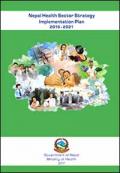
Resource | Publications,
Under the auspices of National Health Policy 2014, Nepal Health Sector Strategy (NHSS) 2016/17-2020/21 is the primary instrument to guide the health sector for the next five years. It adopts the vision and mission set forth by the National Health Policy and carries the ethos of Constitutional provision to guarantee universal access to basic health services.
NHSS places health at the centre of overall socio-economic development. It guides the health sector’s response in realizing government’s vision to graduate Nepal from ‘Least Developed Country’ to ‘Middle Income Developing Country’ by 2022. Developed within the context of Sector Wide Approach (SWAp), it sees partnership as a cornerstone for health development in Nepal. The strategy was developed jointly by the government and its development partners and commit to align their efforts to NHSS priorities and are jointly accountable to achieve the results. NHSS also harnesses multi sectoral approach to address social determinants of health.

Resource | Publications,
The Annual Health Bulletin 2017 is divided into three parts: part one includes State of the Nation’s Health; part two with Millennium Development Goals and National Health Indicator Estimates; and part three with tables and figures. Part one describes progress and challenges of the health system. Part two provides the status of health indicators. This publication is the culmination of monthly routine reports including morbidity, activity and Annual Household Survey report from various health centers in the country.
The publication of an Annual Health Bulletin is aimed to make available the data both for policy directions and programmatic interventions. It also serves an important source of information for various stakeholders including various sectors, UN partners and non-government organizations.
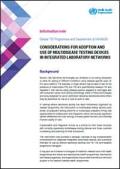
Resource | Publications,
In settings where laboratory testing has been traditionally organized by disease programme, the introduction of multidisease testing devices (also known as polyvalent testing platforms or multianalyte analysers) brings new opportunities for collaboration and integration, which can provide significant system efficiencies and cost savings, increase patient access, and ultimately improve quality of care.
Collaboration and integration should be a priority for both those countries with currently operational multidisease testing devices and those countries considering and planning for their introduction.
This information note provides a strategic overview of key implementation considerations for diagnostic integration using these devices, and is primarily intended for use by national laboratory services and TB, HIV, and hepatitis programme managers.

Resource | Publications,
People who use and inject drugs are among the groups at highest risk of exposure to HIV, but remain marginalized and out of reach of health and social services.
Evidence shows that harm reduction approaches such as needle-syringe programmes reduce the health, social and economic harms of drug use to individuals, communities and societies. They do not cause increases in drug use.
UNAIDS is calling for the global adoption of a peoplecentred, public health and human rights-based approach to drug use and for alternatives to the criminalization and incarceration of people who use drugs.
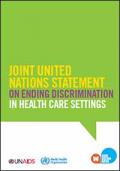
Resource | Publications,
Discrimination in health care settings is directed towards some of the most marginalized and stigmatized populations – the very populations that States promised to prioritize through the 2030 Agenda, and who are all too often excluded or left behind. Many individuals and groups face discrimination on the basis of their age, sex, race or ethnicity, health status, disability or vulnerability to ill health, sexual orientation or gender identity, nationality, asylum or migration status, or criminal record, often experiencing intersecting or compounding forms of discrimination.
Discrimination affects both users of health care services and health care workers. It serves as a barrier to accessing health services, affects the quality of health services provided, and reinforces exclusion from society for both individuals and groups.
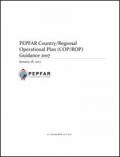
Resource | Publications,
PEPFAR’s focus on gaining sustainable control of the HIV epidemic made possible the announcement of bold PEPFAR HIV prevention and treatment targets for 2017 and 2018 at the 2016 Sustainable Development Goals Summit and the 2016 United Nations General Assembly. The focus on sustainable epidemic control began in 2014, when PEPFAR programs began pivoting to a data-driven approach that strategically targets geographic areas and populations where HIV/AIDS is most prevalent, and in which PEPFAR, in collaboration with host country governments, can achieve the greatest impact. With the focus of scaling HIV services in the highest disease burdened areas now being implemented, the streamlined Country Operational Plan (COP) for Fiscal Year (FY) 2017 focuses on impact and performance.
For the first time, we have evidence that PEPFAR program implementation can change the course of the epidemic evidenced by the impact assessments recently completed in Zambia, Zimbabwe, and Malawi. Controlling the HIV pandemic is possible.
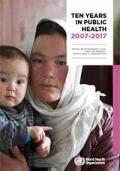
Resource | Publications,
Ten years in public health 2007-2017 chronicles the evolution of global public health over the decade that Dr. Margaret Chan has served as Director-General at the World Health Organization.
This series of chapters evaluates successes, setbacks, and enduring challenges during Dr. Chan's administration. They show what needs to be done when progress stalls or new threats emerge. The chapters show how WHO technical leadership can get multiple partners working together in tandem under coherent strategies. The importance of country leadership and community engagement is stressed repeatedly throughout the chapters.
These chapters tell a powerful story of global challenges and how they have been overcome. In a world facing considerable uncertainty, international health development is a unifying – and uplifting – force for the good of humanity.

Resource | Publications,
To celebrate 20 years since its inception, the World Drug Report 2017 is presented in a new five-booklet format designed to improve reader friendliness while maintaining the wealth of information contained within.
Booklet 1 summarizes the content of the four subsequent substantive booklets and presents policy implications drawn from their findings. Booklet 2 deals with the supply, use and health consequences of drugs. Booklet 3 focuses on the cultivation, production and consumption of the three plant-based drugs (cocaine, opiates and cannabis) and on the impact of new cannabis policies. Booklet 4 provides an extended analysis of the global synthetic drugs market and contains the bulk of the analysis for the triennial global synthetic drugs assessment. Finally, Booklet 5 contains a discussion on the nexus between the drug problem, organized crime, illicit financial flows, corruption and terrorism.





